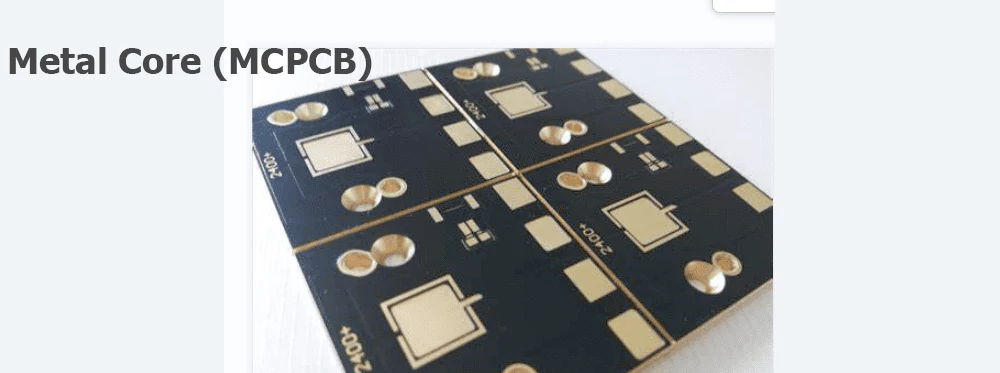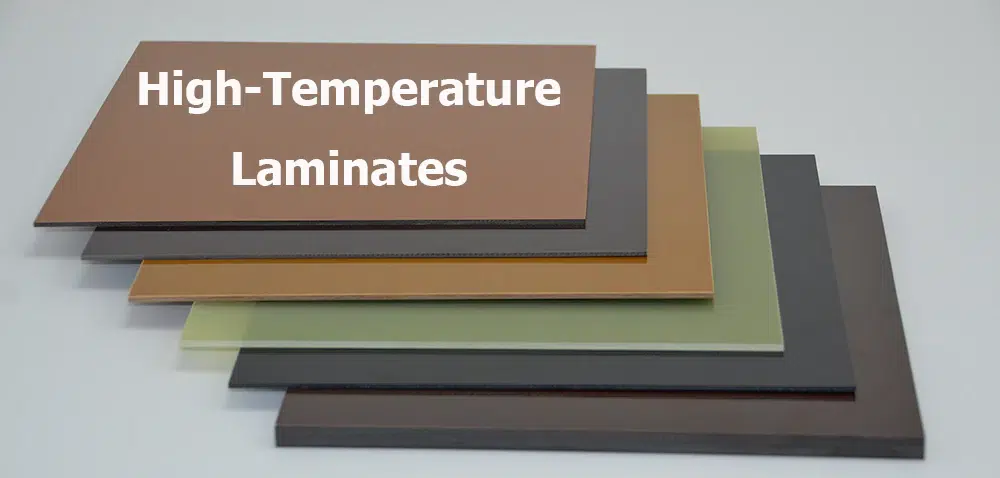PCB materials encompass a wide range of substrates, laminates, and metal cores used in manufacturing printed circuit boards. Here’s a comprehensive list:

FR-4 (Flame Retardant 4)
A widely used epoxy-based laminate reinforced with woven glass fibers. Known for its good electrical insulation and mechanical strength.
FR-4, short for Flame Retardant 4, is a widely used material in the construction of printed circuit boards (PCBs). It’s an epoxy-based substrate reinforced with woven glass fibers, known for its excellent electrical insulation and mechanical properties.
Composition: FR-4 is composed of an epoxy resin binder and a reinforcement material made of woven fiberglass cloth. The resin is impregnated into the glass fabric, and the resulting composite material is then cured under high temperature and pressure to form the substrate.
Properties:
• Electrical Insulation: FR-4 offers high dielectric strength and electrical insulation, making it suitable for various electronic applications.Mechanical Strength: The woven glass reinforcement provides mechanical support, rigidity, and durability to the PCB, allowing it to withstand mechanical stress during handling and operation.
• Thermal Resistance: It has moderate thermal resistance, enabling it to endure typical operating temperatures in electronic devices.
• Flame Retardancy: FR-4 is designed to be flame retardant, meaning it doesn’t easily catch fire and has properties that minimize the spread of flames, a crucial safety feature in electronics.
• Availability: It is widely available and relatively cost-effective, making it a popular choice for a broad range of PCB applications.
Applications:
FR-4 PCBs are utilized across various industries and applications due to their versatile properties:
• Consumer Electronics: Used in smartphones, computers, TVs, and other consumer devices.
Industrial Equipment: Employed in control systems, automation, and power supplies.
• Aerospace and Military: Suitable for applications requiring reliability and durability in harsh environments.
• Automotive Electronics: Found in vehicle control systems, engine management, and infotainment systems.
•Medical Devices: Used in various medical equipment requiring reliability and electrical performance.
Polyimide (PI)
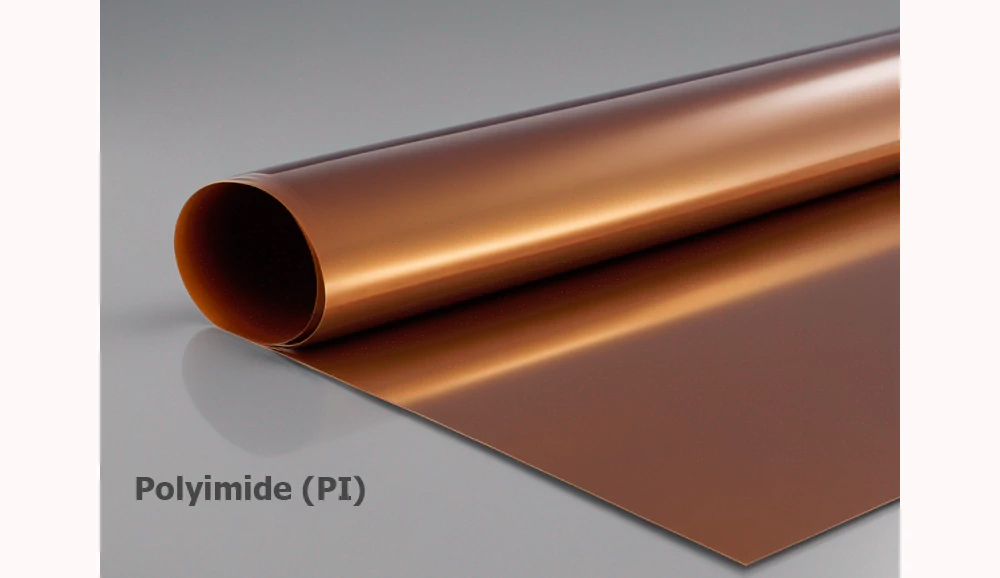
Polyimide (PI) is a high-performance polymer material used in the construction of flexible and high-temperature resistant printed circuit boards (PCBs). It is known for its exceptional thermal stability, mechanical strength, and electrical insulating properties.
Composition: Polyimide is a synthetic polymer derived from the condensation reaction of a dianhydride and a diamine. The resulting material exhibits outstanding properties such as high-temperature resistance, chemical stability, and excellent mechanical strength.
Properties:
• High Thermal Stability: Polyimide maintains its properties over a wide temperature range, making it suitable for applications in high-temperature environments.
• Excellent Electrical Insulation: It possesses superior electrical insulation properties, allowing it to maintain electrical integrity even under extreme conditions.
• Flexibility: Polyimide-based PCBs are flexible, allowing them to bend, fold, or twist without compromising functionality, making them ideal for applications requiring adaptability.
• Chemical Resistance: PI has excellent resistance to various chemicals, oils, and solvents, ensuring durability in harsh operating environments.
• Dimensional Stability: It maintains dimensional stability under varying temperature conditions, crucial for applications where consistency is essential.
Applications:
• Flexible PCBs: Polyimide serves as the base material for flexible PCBs, enabling the creation of circuits that can conform to non-planar shapes and fit into tight spaces.
• High-Temperature Applications: Used in aerospace, automotive, and industrial equipment where high-temperature resistance is critical.
• Miniaturized Devices: Employed in miniaturized electronic devices, sensors, and medical equipment due to its thinness and flexibility.
• Harsh Environments: Suitable for applications requiring resistance to chemicals, moisture, and mechanical stress.
Rogers Materials

Rogers Corporation manufactures a range of high-performance materials specifically designed for printed circuit boards (PCBs). These materials, known as Rogers materials, offer exceptional electrical, thermal, and mechanical properties, making them popular choices for various high-frequency and high-speed electronic applications.
Key Features:
• Dielectric Constant (Dk) Control: Rogers materials are known for their precise control of dielectric constants, which is crucial in RF/microwave applications where signal integrity is paramount.
• Low Loss Tangent (Df): These materials exhibit low dissipation factors (Df), reducing signal loss and maintaining high signal integrity, making them suitable for high-frequency applications.
• Temperature Stability: Rogers materials offer excellent thermal stability, maintaining their electrical properties across a wide temperature range. This feature is crucial for applications exposed to varying thermal conditions.
• Dimensional Stability: They provide good dimensional stability, ensuring consistency in performance under different environmental conditions.
• Substrate Options: Rogers materials come in various substrate options, each tailored for specific applications and frequency requirements.
Applications:
• Wireless Communication: Used in antennas, base stations, and communication systems due to their high-frequency capabilities and low signal loss.
• Aerospace and Defense: Employed in radar systems, satellite communications, and military-grade electronics where reliability and performance in harsh environments are crucial.
• Automotive Radar: Utilized in automotive radar systems for collision avoidance and autonomous driving features due to their high-frequency performance.
• Medical Devices: Used in medical imaging devices and diagnostic equipment that require high signal integrity and reliability.
Aluminum-based
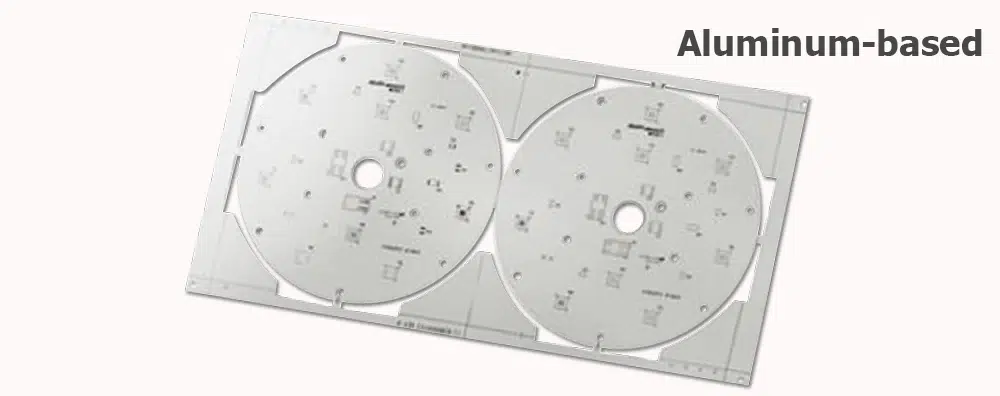
Aluminum-based PCBs, also known as Metal Core PCBs (MCPCBs) or Aluminum PCBs, are a specialized type of printed circuit board designed with a base material composed of an aluminum alloy. These boards are primarily used in applications where effective heat dissipation is crucial, making them ideal for high-power LED lighting, power supplies, automotive systems, and other applications requiring efficient thermal management.
Key Features:
• Thermal Conductivity: The primary advantage of Aluminum PCBs is their exceptional thermal conductivity. The aluminum core efficiently dissipates heat away from heat-generating components, enhancing the reliability and lifespan of the electronics.
• Dielectric Layer: An insulating layer made of dielectric material is sandwiched between the aluminum base and the copper circuit layer. This dielectric layer provides electrical insulation while allowing effective heat transfer.
• Heat Dissipation: Aluminum PCBs can efficiently dissipate heat generated by high-power components, reducing the risk of overheating and maintaining optimal operating temperatures.
• High Power Applications: Due to their excellent thermal management capabilities, these PCBs are preferred for high-power applications like LED lighting, power converters, motor control systems, and automotive electronics.
• Durability: Aluminum-based PCBs are relatively durable and resistant to thermal expansion, making them suitable for applications exposed to varying temperatures.
Applications:
• LED Lighting: Widely used in high-power LED applications, such as street lighting, automotive lighting, and backlighting systems, where efficient heat dissipation is critical for LED performance and longevity.
• Power Supplies: Used in power converters, UPS (Uninterruptible Power Supply) systems, and voltage regulators where efficient heat management is essential.
• Automotive Electronics: Employed in various automotive applications, including power modules, engine control units (ECUs), LED headlights, and other systems requiring reliable thermal performance.
Ceramic-based
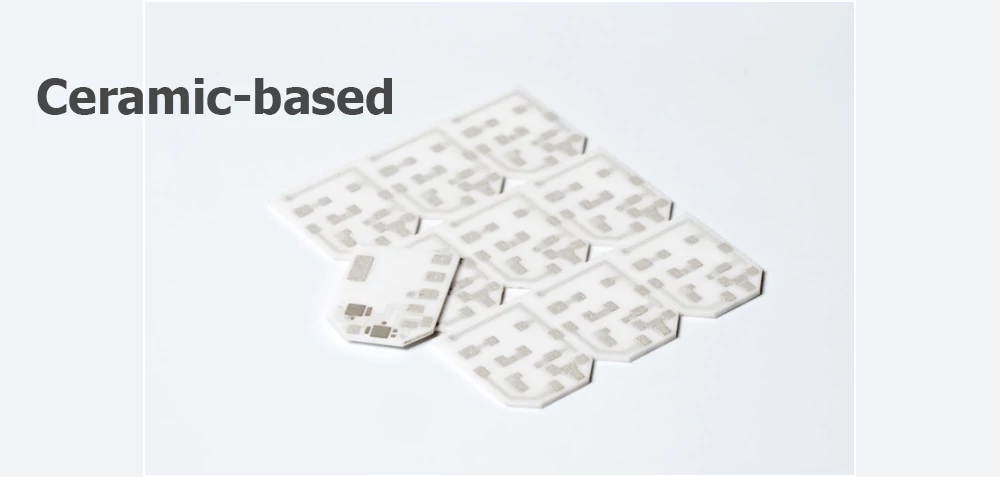
Ceramic-based PCBs, also known as Ceramic PCBs or Ceramic Printed Circuit Boards, utilize a ceramic substrate as the base material for constructing electronic circuits. These substrates are made from various ceramic materials, such as alumina (Al2O3) or aluminum nitride (AlN), and are utilized in applications that require excellent thermal stability, high-frequency performance, and reliability in harsh environments.
Key Features:
• Thermal Stability: Ceramic materials offer exceptional thermal conductivity and stability, enabling efficient dissipation of heat generated by electronic components. This stability allows these boards to withstand high-temperature environments without compromising performance.
• Dielectric Properties: Ceramics have high dielectric strength, making them suitable for high-frequency applications. They exhibit low dielectric loss, which is crucial in maintaining signal integrity and minimizing signal attenuation in high-frequency circuits.
• Reliability: Ceramic-based PCBs offer high mechanical strength and resistance to thermal expansion, ensuring reliability in extreme temperature conditions, making them suitable for aerospace, military, and industrial applications.
• Compatibility with High Temperatures: Ceramic substrates can operate effectively in high-temperature environments, making them ideal for applications requiring resistance to elevated temperatures.
High-Frequency Applications: These boards are well-suited for applications involving high-frequency signals, such as RF/microwave devices, antennas, radar systems, and telecommunications equipment, due to their excellent dielectric properties.
Applications:
• Aerospace and Defense: Used in aerospace and military applications where reliability, thermal stability, and high-frequency performance are critical requirements.
• RF/Microwave Devices: Suitable for wireless communication devices, antennas, radar systems, and other high-frequency applications due to their excellent dielectric properties.
• High-Temperature Environments: Utilized in industries where exposure to extreme temperatures is common, such as automotive electronics, power electronics, and down-hole drilling equipment.
PTFE (Polytetrafluoroethylene/Teflon)

PTFE (Polytetrafluoroethylene), commonly known by the brand name Teflon, is a fluoropolymer material that finds application as a substrate material in specialized Printed Circuit Boards (PCBs). PCBs constructed using PTFE offer unique properties suitable for specific high-frequency and high-performance electronic applications.
Key Features:
• Dielectric Properties: PTFE has excellent dielectric properties, offering low dielectric constant (Dk) and low dissipation factor (Df). These properties enable minimal signal loss and excellent signal integrity, making PTFE ideal for high-frequency applications.
• High Thermal Stability: PTFE has exceptional thermal stability and can operate reliably in high-temperature environments without significantly impacting its electrical properties. This property is crucial in applications where temperature variations are common.
• Chemical Resistance: PTFE is highly resistant to chemicals, solvents, and moisture, ensuring the PCB’s durability and reliability in harsh environmental conditions.
• Low Water Absorption: PTFE has low water absorption properties, which contribute to its stability in various environments and prevent changes in electrical characteristics due to moisture absorption.
• High Mechanical Strength: PTFE-based PCBs offer good mechanical strength and dimensional stability, maintaining their structural integrity in diverse conditions.
Applications:
• High-Frequency Applications: These PCBs are widely used in high-frequency circuits, microwave devices, RF/microwave antennas, radar systems, and telecommunications equipment due to their low loss tangent and stable dielectric properties.
• Aerospace and Defense: PTFE-based PCBs find extensive use in aerospace, defense, and satellite communication systems due to their reliability in extreme conditions and high-frequency performance.
• Medical and Test Equipment: They are utilized in medical devices, testing and measurement equipment, and instrumentation where high precision and reliability are critical.
Metal Core (MCPCB)
Features a metal base (usually aluminum) for better heat dissipation, commonly used in LED applications.
Metal Core Printed Circuit Boards (MCPCBs), also known as Thermal Clad or Metal Clad PCBs, are specialized circuit boards constructed with a metal-based core. These boards have a layer of thermally conductive dielectric material sandwiched between a metal base and a copper foil circuit layer.
Key Features:
• Thermal Conductivity: The metal core (typically aluminum or copper) in MCPCBs facilitates efficient heat dissipation away from heat-generating components. This property is crucial in applications where thermal management is a priority, preventing overheating and ensuring component reliability.
• Structural Integrity: Metal core PCBs offer increased structural integrity compared to standard FR-4 boards due to the robustness of the metal core. This makes them suitable for applications subject to mechanical stress or where durability is essential.
• Heat Resistance: The dielectric material used in MCPCBs offers high-temperature resistance, ensuring the board’s stability in elevated temperature environments. This property is vital in applications where components generate substantial heat during operation.
• Thermal Expansion: The coefficient of thermal expansion (CTE) of the metal core is matched with that of semiconductor materials, reducing the risk of failure caused by thermal mismatch.
Applications:
• LED Lighting: MCPCBs are extensively used in LED lighting applications due to their ability to dissipate heat effectively, enhancing LED performance and lifespan.
• Automotive Systems: They are utilized in automotive electronics, power controllers, motor drives, and various vehicle control systems due to their reliability and thermal management capabilities.
• Power Supplies and Converters: MCPCBs find application in power supplies, voltage regulators, and converters where thermal management is crucial for efficient operation.
• Consumer Electronics: In certain high-performance consumer electronics such as high-power amplifiers, MCPCBs are used to manage thermal dissipation.
FR-2 (Flame Retardant 2)
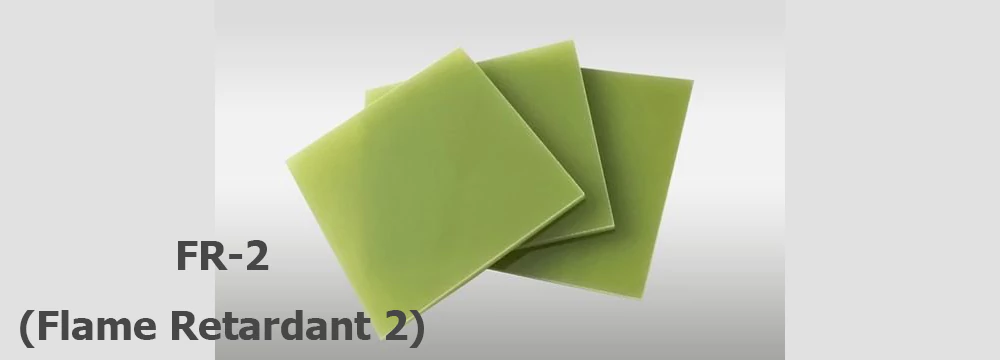
FR-2, or Flame Retardant 2, is a type of PCB material primarily used in low-cost, low-power applications. It’s a common substrate material made from paper reinforced with phenolic resin and is often referred to as Paper Phenolic.
Key Features:
• Affordability: FR-2 material is cost-effective due to its composition, making it a preferred choice for applications with budget constraints.
• Ease of Fabrication: It’s relatively easy to work with during the PCB manufacturing process. FR-2 boards can be easily machined, cut, and drilled.
• Electrical Insulation: Despite its lower electrical performance compared to other materials, FR-2 provides sufficient insulation for low-voltage applications.
• Flame Retardancy: As the name suggests, FR-2 material is flame-retardant, which enhances its safety profile, making it suitable for various electronic applications.
Applications:
• Consumer Electronics: Commonly used in consumer electronics with low-voltage requirements, such as toys, remote controls, and simple electronic devices.
• Education and Prototyping: FR-2 PCBs are often used in educational settings and prototyping due to their affordability and ease of use.
Limitations:
Limited Performance: FR-2 material has limitations in terms of high-frequency applications and thermal performance due to its relatively lower electrical properties and heat resistance compared to more advanced materials like FR-4 or higher-grade substrates.
CEM-1 (Composite Epoxy Material-1)
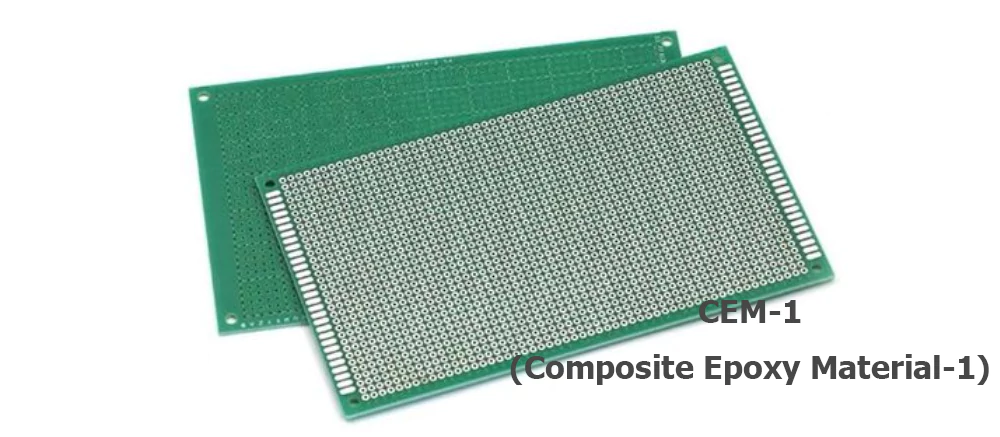
CEM-1, short for Composite Epoxy Material-1, is a cost-effective substrate used in the manufacturing of printed circuit boards (PCBs). It’s a composite material consisting of woven glass fabric and paper impregnated with epoxy resin.
Key Features:
• Affordability: CEM-1 is relatively inexpensive compared to higher-grade materials, making it a preferred choice for cost-sensitive applications.Ease of Fabrication: It’s relatively easy to machine, cut, and drill during the PCB manufacturing process, contributing to its popularity for simple PCB designs.
• Good Mechanical Properties: CEM-1 offers decent mechanical strength and dimensional stability, providing adequate support for component mounting.
• Limited Thermal Performance: While it can handle standard operating temperatures, CEM-1 may not be suitable for applications requiring high thermal resistance.
Applications:
• Consumer Electronics: Used in low- to mid-range consumer electronics where cost is a critical factor, such as audio systems, calculators, and control panels.
• Light Industrial Applications: Suitable for applications that don’t involve extreme temperatures or demanding electrical properties, like industrial control boards.
CEM-3 (Composite Epoxy Material-3)
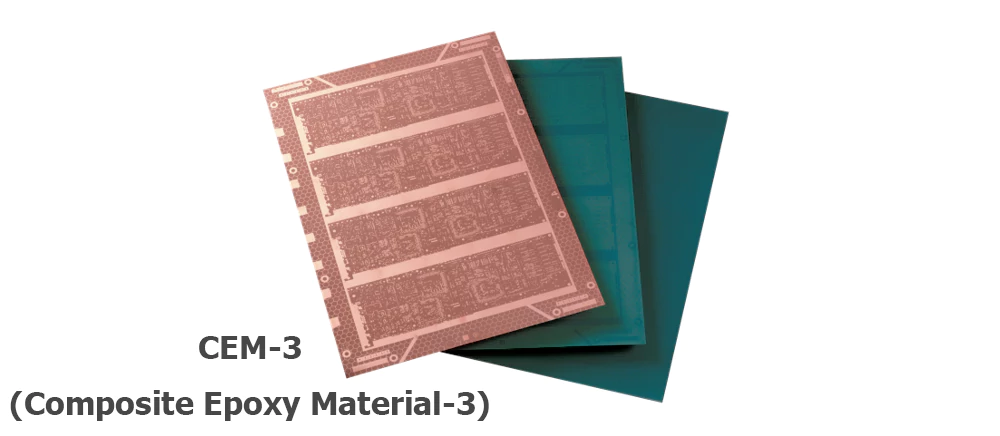
CEM-3, known as Composite Epoxy Material-3, is a type of substrate material widely used in printed circuit boards (PCBs). It is an improvement over CEM-1 (Composite Epoxy Material-1) in terms of performance and reliability.
Key Features:
• Enhanced Performance: CEM-3 offers better electrical and mechanical properties compared to CEM-1. It provides improved strength and durability.
• Good Thermal Resistance: CEM-3 exhibits better resistance to heat compared to CEM-1, allowing it to withstand higher operating temperatures.
• Cost-Effective: While offering improved performance, CEM-3 remains relatively cost-effective, making it a preferred choice for applications where moderate performance is required without significantly increasing costs.
• Ease of Fabrication: Similar to CEM-1, CEM-3 is relatively easy to machine, drill, and fabricate during the PCB manufacturing process.
Applications:
• Consumer Electronics: Commonly used in various consumer electronics such as televisions, radios, and home appliances where moderate thermal and electrical properties are sufficient.
• Industrial Controls: Suitable for applications in control systems, automation equipment, and instrumentation where reliability and moderate performance are essential.
Limitations:
Not for High-Performance Requirements: CEM-3 may not be suitable for high-frequency or high-speed applications that demand advanced electrical characteristics and superior thermal stability.
Medium Thermal Performance: While offering better thermal resistance than CEM-1, CEM-3 may not suffice for applications requiring extremely high thermal resistance.
Nelco Materials
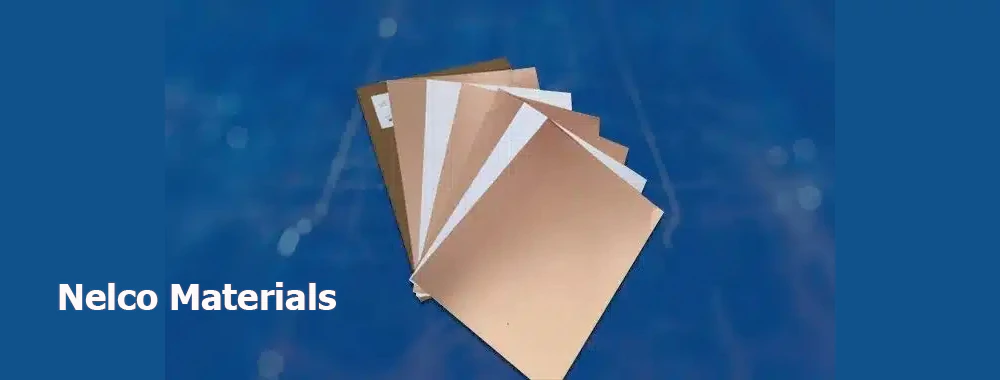
Nelco materials, specifically Nelco PCB laminates, refer to a range of high-performance substrates used in the manufacture of printed circuit boards (PCBs). These materials are engineered to offer specific electrical, thermal, and mechanical properties required for various electronic applications.
Key Features:
• High-Frequency Performance: Nelco laminates are designed to maintain stable electrical characteristics at high frequencies, making them suitable for applications requiring excellent signal integrity and low loss.
• Thermal Stability: These materials exhibit good thermal performance, withstanding elevated temperatures during soldering and operation, which is crucial for reliability in demanding environments.
• Low Dielectric Constant (Dk) and Dissipation Factor (Df): Nelco materials are known for their low Dk and Df values, which contribute to minimal signal loss and attenuation, especially in high-speed digital applications.
• Dimensional Stability: They offer good dimensional stability, minimizing issues related to thermal expansion, warping, or delamination during PCB fabrication and assembly.
• Halogen-Free Options: Some Nelco laminates are available in halogen-free formulations, meeting environmental and safety standards.
Applications:
• High-Speed PCBs: Suitable for high-speed digital designs, such as high-frequency communication systems, networking equipment, and data centers, where signal integrity and low loss are critical.
• RF/Microwave Applications: Used in radio frequency (RF) and microwave circuits where maintaining consistent electrical performance across a range of frequencies is essential.
• Automotive Electronics: Selected for automotive applications requiring reliable PCBs capable of withstanding challenging temperature conditions.
• Aerospace and Defense: Utilized in aerospace and defense sectors for their high reliability, low loss, and excellent electrical performance.
High-Temperature Laminates
Specialty materials capable of withstanding extreme temperatures, often used in aerospace or military applications.
High-temperature laminates refer to a category of materials specifically engineered to withstand and maintain their structural and electrical integrity at elevated temperatures, well beyond the capabilities of standard PCB substrates like FR-4. These materials are designed to operate reliably in extreme heat environments without compromising performance.
Key Features:
• Thermal Resistance: These laminates offer excellent thermal stability, allowing them to endure high temperatures without significant degradation of their electrical or mechanical properties. They can withstand prolonged exposure to elevated temperatures encountered during assembly processes like reflow soldering.
• Dielectric Properties: High-temperature laminates maintain stable electrical characteristics, including low dielectric constants (Dk) and low dissipation factors (Df), ensuring minimal signal loss even at extreme temperatures.
• Mechanical Strength: They exhibit good mechanical strength, ensuring the structural integrity of the PCB even under thermal stress, preventing warping or delamination.
• Reliability: These materials are chosen for applications requiring long-term reliability in high-temperature environments, such as automotive, aerospace, downhole oil drilling, and certain industrial applications.
• Material Variety: High-temperature laminates come in various types and formulations, including polyimide-based materials, PTFE (Teflon)-based materials, ceramic-filled materials, and others, each offering specific advantages for different applications.
Applications:
• Aerospace and Defense: Commonly used in avionics, satellites, and military equipment where extreme temperatures and harsh conditions are prevalent.
• Automotive Electronics: Employed in engine control units, sensors, and under-the-hood components that experience high temperatures.
• Oil and Gas Industry: Utilized in downhole drilling applications where equipment is subjected to high temperatures and pressures.
• Industrial Electronics: Suitable for industrial equipment operating in high-temperature environments, such as ovens, furnaces, and certain manufacturing machinery.
FR-4, short for Flame Retardant 4, is a widely used material in the construction of printed circuit boards (PCBs). It's an epoxy-based substrate reinforced with woven glass fibers, known for its excellent electrical insulation and mechanical properties.
Rogers Corporation manufactures a range of high-performance materials specifically designed for printed circuit boards (PCBs). These materials, known as Rogers materials, offer exceptional electrical, thermal, and mechanical properties, making them popular choices for various high-frequency and high-speed electronic applications.
Aluminum-based PCBs, also known as Metal Core PCBs (MCPCBs) or Aluminum PCBs, are a specialized type of printed circuit board designed with a base material composed of an aluminum alloy.

